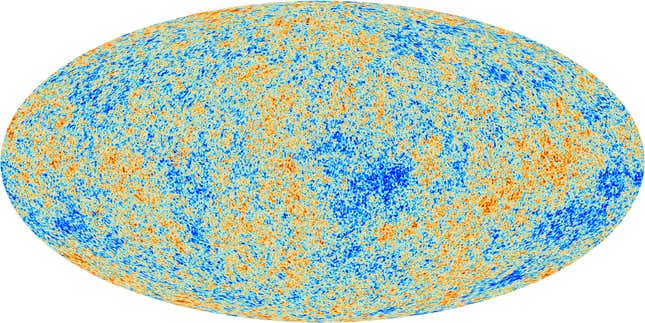
Scientists using data from the Atacama Cosmology Telescope in Chile have made a detailed map of dark matter’s distribution across a quarter of the sky.
The map shows regions the distribution of mass extending essentially as far we can see back in time; it uses the cosmic microwave background as a backdrop for the dark matter portrait. The team’s research will be presented at the Future Science with CMB x LSS conference in Kyoto, Japan.
“We have mapped the invisible dark matter across the sky to the largest distances, and clearly see features of this invisible world that are hundreds of millions of light-years across,” said Blake Sherwin, a cosmologist at the University of Cambridge, in a Princeton University release. “It looks just as our theories predict.”
Dark matter is a catch-all term for the stuff that makes up about 27% of the universe, but it is not directly observable. We only know it’s there, whatever it is, because of its gravitational effects.
People probe dark matter through two main approaches: Earth-based experiments and sweeping observations of the cosmos. There are plenty of experiments that try to identify dark matter amidst a sea of proposed dark matter candidates, which include axions and Weakly Interacting Massive Particles (WIMPs).
But the only way dark matter is observed is indirectly, in the way its gravitational effects are observed at large scales. Enter the Atacama Cosmology Telescope, which more precisely dated the universe in 2021. The telescope’s map builds on a map of the universe’s matter released earlier this year, which was produced using data from the Dark Energy Survey and the South Pole Telescope. That map upheld previous estimations of the ratio of ordinary matter to dark matter and found that the distribution of the matter was less clumpy than previously thought.
The new map homes in on a lingering concern of Einstein’s general relativity: how the most massive objects in the universe, like supermassive black holes, bend light from more distant sources. One such source is the cosmic microwave background, the most ancient detectable light, which radiates from the aftermath of the Big Bang.
The researchers effectively used the background as a backlight, to illuminate regions of greater density in the universe.
“It’s a bit like silhouetting, but instead of just having black in the silhouette, you have texture and lumps of dark matter, as if the light were streaming through a fabric curtain that had lots of knots and bumps in it,” said Suzanne Staggs, director of the Atacama Cosmology Telescope and a physicist at Princeton, in the university release.

“The famous blue and yellow CMB image is a snapshot of what the universe was like in a single epoch, about 13 billion years ago, and now this is giving us the information about all the epochs since,” Staggs added.
The recent analysis suggests that the dark matter was lumpy enough to fit with the standard model of cosmology, which relies on Einstein’s theory of gravity.
Eric Baxter, an astronomer at the University of Hawai’i and a co-author of the research that resulted in the February dark matter map, told Gizmodo in an email that his team’s map was sensitive to low-redshifts (meaning close by, in the more recent universe). On the other hand, the newer map focuses exclusively on the lensing of the cosmic microwave background, meaning higher redshifts and a more sweeping scale.
“Said another way, our measurements and the new ACT measurements are probing somewhat different (and complementary) aspects of the matter distribution,” Baxter said. “Thus, rather than contradicting our previous results, the new results may be providing an important new piece of the puzzle about possible discrepancies with our standard cosmological model.”
“Perhaps the Universe is less lumpy than expected on small scales and at recent times (i.e. the regime probed by our analysis), but is consistent with expectations at earlier times and at larger scales,” Baxter added.
New instruments should help tease out the matter distribution of the universe. An upcoming telescope at the Simons Observatory in the Atacama is set to begin operations in 2024 and will map the sky nearly 10 times faster than the Atacama Cosmology Telescope, according to the Princeton release.
With the largest digital camera ever built set to be installed at the Vera Rubin Observatory, also in the Atacama, it’s an exciting time for Earth-based observatories.
More: New Dark Matter Theory Says a ‘Dark Big Bang’ Created the Hidden Universe

